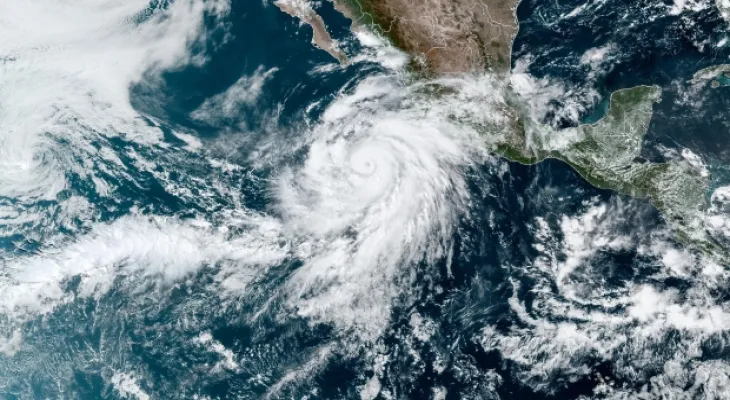Search here
Newspaper
Search here

Arab Canada News
News

Published: August 20, 2023
Tropical Storm Hilary is nearing landfall in Mexico's Baja California Peninsula, where it remains a dangerous Category 1 hurricane bringing so much rain that forecasters have warned of catastrophic and life-threatening flooding, likely to extend across a wide area of the southwestern United States.
The National Weather Service in Miami said that as of 5 a.m., the storm was "very close" to the Baja coast south of Ensenada, and 285 miles (460 kilometers) from San Diego, California, with sustained maximum winds dropping to 80 mph (130 km/h) as heavy rain spread northward over the peninsula.
Forecasters warned that the storm remains treacherous despite its weakening, as one person drowned on Saturday in the Mexican town of Santa Rosalia on the eastern coast of the peninsula when a vehicle was swept away in a waterway. Edith Aguilar Villavicencio, the mayor of the town of Mulegé, said rescue workers were able to save four other people.
It was not immediately clear if officials considered the death related to the hurricane, but video posted by local officials showed torrents of water flowing through the streets of the town.
Forecasters said the storm is still expected to go down in the history books as the first tropical storm to hit Southern California in 84 years, causing flooding, mudslides, scattered tornadoes, high winds, and power outages. Authorities issued an evacuation warning for Santa Catalina Island, urging residents and beachgoers to leave the tourist destination located 23 miles (37 kilometers) off the coast.
Elizabeth Adams, a meteorologist with the National Weather Service in San Diego, said rain could reach up to 3 inches (7.62 cm) per hour across the mountains and deserts of Southern California from late Sunday morning into the afternoon. Heavy rain during those hours could cause widespread and life-threatening flooding.
California Governor Gavin Newsom declared a state of emergency, and officials urged people to complete their preparations before sunset on Saturday. One expert said it would be too late by Sunday.
The hurricane is the latest major climate disaster wreaking havoc across the United States, Canada, and Mexico. Maui, Hawaii, is still reeling from last week’s fire that killed more than 100 people and devastated the historic town of Lahaina, making it the deadliest wildfire in the United States in over a century. In Canada, firefighters continued to battle blazes during the country’s worst wildfire season on record.
Hilary had already brought heavy rain and flooding to Mexico and the southwestern United States on Saturday, ahead of the storm’s expected border crossing on Sunday. Forecasters warned that up to 10 inches (25 cm) of rain could fall—equivalent to a year’s worth of rain in some areas of Southern California and southern Nevada.
Jimmy Rom, deputy director of the National Hurricane Center, said during a briefing on Saturday to announce the downgrade of the storm, "This doesn’t lessen the threat, especially the threat of flooding, so don’t let the weakening trend and intensity lessen your guard."
Meteorologists also expect the storm to bring life-threatening waves and dangerous currents, including waves reaching up to 40 feet (12 meters) along the Pacific coast of Mexico, prompting dozens to seek refuge in storm shelters in the twin resorts of Los Cabos at the southern tip of the Baja Peninsula. Rescue workers saved a family in San José del Cabo after the resort was hit by heavy rain and winds.
In Tijuana, Fire Chief Rafael Carrillo expressed the fear that grips everyone in the border city of 1.9 million people, especially residents living in homes on steep hillsides.
Carrillo said, "If you hear noise, or the ground is cracking, it’s important to check that out and get out as quickly as you can because the ground can weaken, and your home could collapse." Tijuana ordered all beaches closed on Saturday and set up six storm shelters in sports complexes and government offices.
The Mexican Navy evacuated 850 people from islands off the Baja coast and deployed nearly 3,000 soldiers for emergency operations. In La Paz, the picturesque capital of Baja California Sur overlooking the Sea of Cortez, police patrolled closed beaches to keep swimmers away from the waves.
The U.S. Hurricane Center issued tropical storm and potential flood warnings for Southern California from the Pacific Coast to the inland mountains and deserts, while the San Bernardino County mayor issued evacuation warnings for several mountain communities and foothills ahead of the storm. Orange County sent its own alert to anyone living in Silverado Canyon and Williams in the Santa Ana Mountains.
Authorities in Los Angeles rushed to get homeless people off the streets and into shelters, and officials ordered all state beaches in San Diego and Orange counties closed.
Across the region, free sandbags ran out from municipalities, and grocery shelves were emptied as residents stocked up on supplies. The U.S. National Park Service closed Joshua Tree National Park and Mojave National Preserve in California to prevent visitors from becoming stranded amid flooding.
Hilary rapidly escalated on Friday to become a dangerous Category 4 hurricane, with sustained winds peaking at 145 mph (230 km/h). Its winds dropped to 115 mph (185 km/h) early Saturday as a Category 3 storm before weakening to 100 mph (161 km/h) as a Category 2.
By Sunday, it was moving from the north to the northwest at 21 mph (33 km/h). The hurricane passed Punta Eugenia on the Pacific coast and was expected to make landfall along a sparsely populated area of the peninsula south of the coastal city of Ensenada on the Pacific.
Comments